Yes, you can do it but with some modification to your proposed algorithm. In order to train your network, you need to know error (which you are computing), but also the direction of the error (derivative) with respect to the activity of the neuron and the weight. So you need to know if the error would increase or decrease if you change the weight.
So you can do
- compute outputs for all your samples (and save activations of the neurons for each sample)
- compute where should each of your sample move, to minimize your custom criterion.
- us this as the error term in your training and update your weights accordingly
Another question is however if the neural network is the right tool to do it. For example if you want to find projection that would maximize variance, (nonlinear) PCA might be better.
Edit:
Although after bounty period, but here is an example hacky code that does that.
This is a neural network trained to create outputs that are equally distant from each other.
import numpy as np
from sklearn import neural_network
def get_new_targets(x):
"""
Function to get points that are in the middle of the neighbouring points"""
try:
x = [e[1] for e in x]
except:
pass
enumerated_x = [e for e in enumerate(x)]
enumerated_x.sort(key=lambda x: x[1])
targets = []
for i, elem in enumerate(enumerated_x):
previous_sample, next_sample = 0, 0
# current_sample = enumerated_x[i][1]
if i == 0:
previous_sample = 0
else:
previous_sample = enumerated_x[i-1][1]
if i == len(enumerated_x)-1:
next_sample = 50
else:
next_sample = enumerated_x[i+1][1]
target = (previous_sample + next_sample)/2.
targets.append(target)
targets_in_order = sorted([(enum[0], t) for enum, t in zip(enumerated_x, targets)])
targets_in_order = [e[1] for e in targets_in_order]
return np.array(targets_in_order)
# create training data
# in this example we care only about one axis
X = np.array([[0,3], [0,4], [0,10], [0,15], [0,35], [0,36] ,[0,50]])
# create initial targers. This will change every epoch
Y = get_new_targets(X)
preds = [] # save predictions
epochs = []
# warm start True and max_iter 1 to simulate batch training
clf = neural_network.MLPRegressor(max_iter=1, warm_start=True, alpha=0.005,
hidden_layer_sizes=(50,), activation='logistic')
for i in range(4000): # for each epoch
# since warms_start=True it will reuse weights from previous epoch
clf.fit(X, Y)
predictions = clf.predict(X)
Y = get_new_targets(predictions)
if i % 100 == 0:
pred = clf.predict(X)
preds.append([pred])
epochs.append(i)
Plots that show that it kindof worked, but not really




